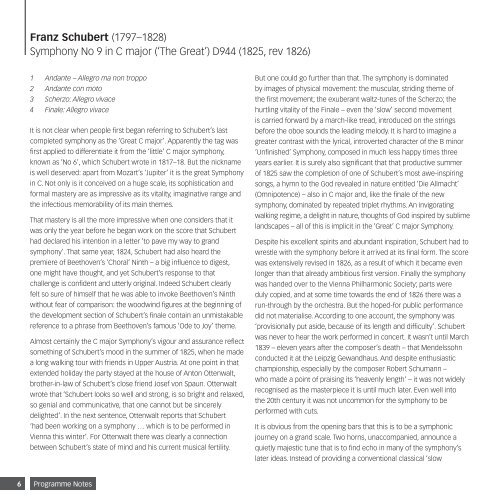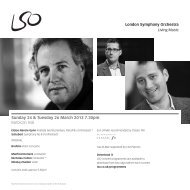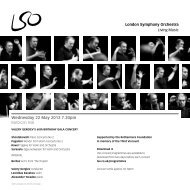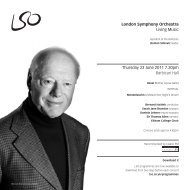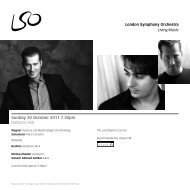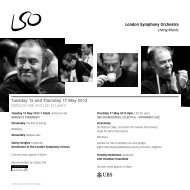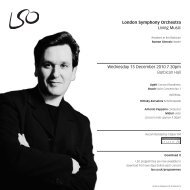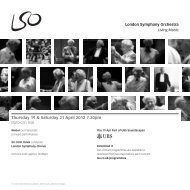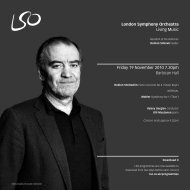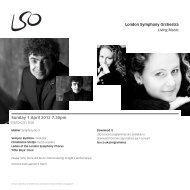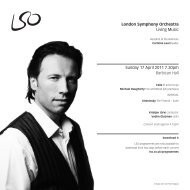Sunday 10 June 2012 - London Symphony Orchestra
Sunday 10 June 2012 - London Symphony Orchestra
Sunday 10 June 2012 - London Symphony Orchestra
You also want an ePaper? Increase the reach of your titles
YUMPU automatically turns print PDFs into web optimized ePapers that Google loves.
Franz Schubert (1797–1828)<br />
<strong>Symphony</strong> No 9 in C major (‘The Great’) D944 (1825, rev 1826)<br />
1 Andante – Allegro ma non troppo<br />
2 Andante con moto<br />
3 Scherzo: Allegro vivace<br />
4 Finale: Allegro vivace<br />
It is not clear when people first began referring to Schubert’s last<br />
completed symphony as the ‘Great C major’. Apparently the tag was<br />
first applied to differentiate it from the ‘little’ C major symphony,<br />
known as ‘No 6’, which Schubert wrote in 1817–18. But the nickname<br />
is well deserved: apart from Mozart’s ‘Jupiter’ it is the great <strong>Symphony</strong><br />
in C. Not only is it conceived on a huge scale, its sophistication and<br />
formal mastery are as impressive as its vitality, imaginative range and<br />
the infectious memorability of its main themes.<br />
That mastery is all the more impressive when one considers that it<br />
was only the year before he began work on the score that Schubert<br />
had declared his intention in a letter ‘to pave my way to grand<br />
symphony’. That same year, 1824, Schubert had also heard the<br />
premiere of Beethoven’s ‘Choral’ Ninth – a big influence to digest,<br />
one might have thought, and yet Schubert’s response to that<br />
challenge is confident and utterly original. Indeed Schubert clearly<br />
felt so sure of himself that he was able to invoke Beethoven’s Ninth<br />
without fear of comparison: the woodwind figures at the beginning of<br />
the development section of Schubert’s finale contain an unmistakable<br />
reference to a phrase from Beethoven’s famous ‘Ode to Joy’ theme.<br />
Almost certainly the C major <strong>Symphony</strong>’s vigour and assurance reflect<br />
something of Schubert’s mood in the summer of 1825, when he made<br />
a long walking tour with friends in Upper Austria. At one point in that<br />
extended holiday the party stayed at the house of Anton Ottenwalt,<br />
brother-in-law of Schubert’s close friend Josef von Spaun. Ottenwalt<br />
wrote that ‘Schubert looks so well and strong, is so bright and relaxed,<br />
so genial and communicative, that one cannot but be sincerely<br />
delighted’. In the next sentence, Ottenwalt reports that Schubert<br />
‘had been working on a symphony … which is to be performed in<br />
Vienna this winter’. For Ottenwalt there was clearly a connection<br />
between Schubert’s state of mind and his current musical fertility.<br />
6 Programme Notes<br />
But one could go further than that. The symphony is dominated<br />
by images of physical movement: the muscular, striding theme of<br />
the first movement; the exuberant waltz-tunes of the Scherzo; the<br />
hurtling vitality of the Finale – even the ‘slow’ second movement<br />
is carried forward by a march-like tread, introduced on the strings<br />
before the oboe sounds the leading melody. It is hard to imagine a<br />
greater contrast with the lyrical, introverted character of the B minor<br />
‘Unfinished’ <strong>Symphony</strong>, composed in much less happy times three<br />
years earlier. It is surely also significant that that productive summer<br />
of 1825 saw the completion of one of Schubert’s most awe-inspiring<br />
songs, a hymn to the God revealed in nature entitled ‘Die Allmacht’<br />
(Omnipotence) – also in C major and, like the finale of the new<br />
symphony, dominated by repeated triplet rhythms. An invigorating<br />
walking regime, a delight in nature, thoughts of God inspired by sublime<br />
landscapes – all of this is implicit in the ‘Great’ C major <strong>Symphony</strong>.<br />
Despite his excellent spirits and abundant inspiration, Schubert had to<br />
wrestle with the symphony before it arrived at its final form. The score<br />
was extensively revised in 1826, as a result of which it became even<br />
longer than that already ambitious first version. Finally the symphony<br />
was handed over to the Vienna Philharmonic Society; parts were<br />
duly copied, and at some time towards the end of 1826 there was a<br />
run-through by the orchestra. But the hoped-for public performance<br />
did not materialise. According to one account, the symphony was<br />
‘provisionally put aside, because of its length and difficulty’. Schubert<br />
was never to hear the work performed in concert. It wasn’t until March<br />
1839 – eleven years after the composer’s death – that Mendelssohn<br />
conducted it at the Leipzig Gewandhaus. And despite enthusiastic<br />
championship, especially by the composer Robert Schumann –<br />
who made a point of praising its ‘heavenly length’ – it was not widely<br />
recognised as the masterpiece it is until much later. Even well into<br />
the 20th century it was not uncommon for the symphony to be<br />
performed with cuts.<br />
It is obvious from the opening bars that this is to be a symphonic<br />
journey on a grand scale. Two horns, unaccompanied, announce a<br />
quietly majestic tune that is to find echo in many of the symphony’s<br />
later ideas. Instead of providing a conventional classical ‘slow


